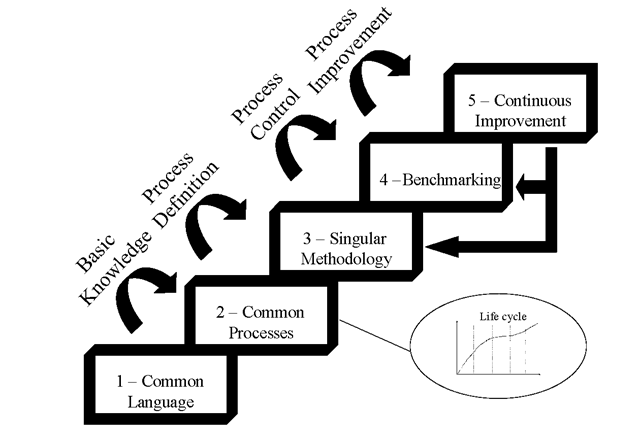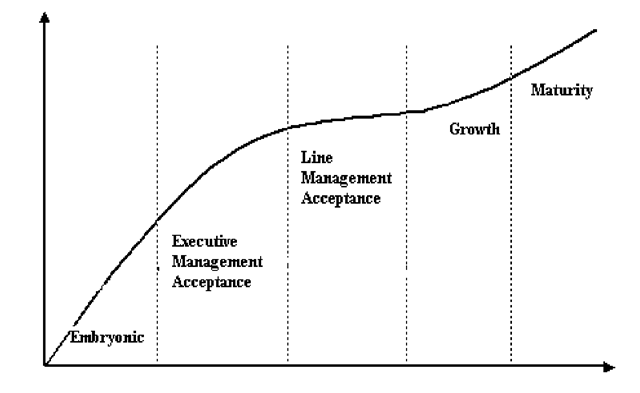INTRODUCTION
The implementation of formal efficiency procedures is quite new in IT projects. There are different approaches regarding the best practices in the IT project management (Carvalho, Laurindo & Pessoa, 2003; Laurindo, Carvalho & Shimizu, 2003).
Humphrey (1989) identifies maturity levels in the IT project development process, based on the managerial behavior found in companies. The fundamental concepts of the process maturity derive from the belief that the development management process is evolutionary. Paulk, Weber, and Curtis (1995) identify the distinguishing characteristics between immature and mature organizations, as showed in Table 1.
CAPABILITY MATURITY MODEL (CMM)
The CMM (Humphrey, 1989; Paulk et al., 1995; Pessoa & Spinola, 1997) was developed by SEI—the Software Engineering Institute of Carnegie Mellon University—and presents five maturity levels, each corresponding to a set of structural requirements for key process areas (Figure 1).
Although each project is unique, it could be organized in a process to be applied in other projects. IT project managers used to apply a “methodology,” that is, they established the steps to be followed in order to develop a system. Another singular characteristic is the dynamic technologies breakthrough that demands continuous improvements in the development methods and management of changing process, as described in CMM model, at Level 5, the highest level of maturity.
The CMM second level has a consistent project management structure, and the goal of this level is to deliver projects on time. To perform this, the model has several points that must be achieved, like effort and size estimation, strong process control (such as periodic meetings between technical people and managers), and several measures to show project status more clearly.
CMM is not an adequate reference for the assessment of internal methodologies, since it was not conceived to perform this kind of analysis. ISO 15504 (1998) proposed the standard project SPICE as a more appropriate model to evaluate maturity level of specific processes. While CMM level of maturity specifies a set of processes that have to be performed, ISO 15504 establishes maturity levels for each individual process: Level 0—Incomplete; Level 1—a framework to manage project efficiency, balancing scope expectations and the available resources in nine key areas (Rabechini & Carvalho, 1999).
Table 1. Immature organization x mature organization (Paulk et al., 1995)
| IMMATURE ORGANIZATION | MATURE ORGANIZATION |
| Ad hoc; improvised process by practitioners and managers Not rigorously followed and not controlled Highly dependent on personal knowledge Little understanding of progress and quality Compromising product functionality and quality to meet schedule High risk when new technology is applied High maintenance costs and unpredictable quality |
Coherent with action plans; the work is effectively achieved Processes are documented and continuously improved Perceptible top and middle management commitment Well controlled assessment of the process Product and process measures are used Disciplined use of technology |
Figure 3. Project management maturity model

Nevertheless, the PMBoK framework cannot provide a standard benchmark for project management capability as CMM to software engineering capabilities. In order to extend the Capability Maturity Model to project management, Kerzner (2000, 2001) proposes a Project Management Maturity Model (PMMM).
The PMMM differs in many aspects from the CMM, but this framework also introduces benchmarking instruments for measuring an organization’s progress along the maturity model, detailing five levels of development for achieving maturity, as shown in Figure 3 (Carvalho et al.,2003).
It is important to highlight the differences in terminology between the CMM and PMMM (compare Figures 2 and 3) which could lead to misunderstanding when both models are being implemented in the IT domain of the same organization.
PMMM addresses the key knowledge areas across the project management process, in compliance with PMBoK, and integrates them with the Project Management Office (PMO) in the strategic level.
Kerzner (2000) identifies a life cycle in PMMM Level 2, Common Processes, which could be broken into five phases, as shown in Figure 4. It is important to note that some simultaneity among the phases can occur.
The embryonic phase means that the organization starts to recognize the benefits of project management (PM), usually by lower and middle levels of management.
The two next phases are achieved when the PM concepts are accepted, and have visible support and commitment by executive and line management.
Kerzner (2001) emphasizes the growth phase as the most critical, because it is the beginning of the creation of the PM process and warns that different methodologies for each project should be avoided.
The last life cycle phase—maturity—is difficult to achieve due to several factors such as organizational resistance to project cost control and horizontal accounting.
The main characteristics of these life cycle phases emphasized by Kerzner (2001) are described in Table 2.
QUALITY SYSTEMS
It is important to note that the adoption of systems models, such as ISO 9000, focuses on the creation and maintenance of a quality system, applied to any process. The ISO 9001:2000 new version, published in the year 2000, was fully restructured to have a more clear process-focused approach. Other ISO standards offer an overview of these standards to the software field and contribute to deploying this approach to specific processes such as software products (ISO 9126-NBR 13596), quality requirements for software packages (ISO 12119), and the software life cycle process (ISO 12207).
ISO 9000-3 (2001) is a guide to help with ISO 9001 interpretation for the software field (Pessoa & Spinola,1997). The previous versions of this guide were developed by the ISO/TC/SC2 committee, the quality branch of ISO. Nowadays this ISO 9000-3 guide is being revised by ISO/IEC JTC1/SC7, the information technology branch. The ISO 9001:2000 new structure made this task easier than previous versions, and it is incorporating a map of the relationship between IT standards (ISO/IEC JTC1/ SC7) and its respective quality systems described in ISO 9001 to this standard. For example, ISO 9001 specifies that the organizations have to identify their processes, and ISO 12207 proposes a set of processes involving software development, supply, acquisition, and maintenance. In addition to ISO 12207, other standards are referenced, such as ISO 9126 for software products, ISO 12119 for quality requirements for software packages, and ISO 15504 for software evaluation. This was considered an improvement of the standards structure that matches quality system standards with technical and specific standards.
Table 2. Life cycle phases’ characteristics
| Phase | Characteristics | |
| embryonic | recognizing the need for PM recognizing PM’s potential benefits | |
| applications of PM to the business | ||
| recognizing the changes necessary to implement PM | ||
| executive management | visible executive support | |
| acceptance | executive understanding of PM | |
| project sponsorship | ||
| willingness to change the way the company does business | ||
| line management | visible line management support | |
| acceptance | line management commitment to PM | |
| line management education | ||
| release of functional employees for PM training programs | ||
| growth | development of company PM life cycles development of a PM methodology a commitment to effective planning | |
| minimization of scope | ||
| selection of PM software to support methodology | ||
| maturity | development of a management cost/schedule control system | |
| integration of schedule and cost control | ||
| development of an educational curriculum to support PM | ||
ISO 9001:2000 standards have the purpose of certifying organizations whose quality systems comply with the standards, and provides a structure to manage quality independently of the organizational activity. This is not enough for specific fields of application, and for this reason there are complementary sets of standards in some areas, like QS-9000 for the automobile industry and TL-9000 for the telecommunications industry.
The standards from ISO/IEC JTC1/SC7 have the purpose of complementing the quality system for the IT-specific area, not focusing on applications as with the automobile or telecommunications industry, but considering the specifics of software and systems development.
In general, ISO 9000 can be a good starting point for implementing a quality system. This system allows organizations to disseminate quality culture and create the initial structure to implement more specific quality systems.
In general, the quality system (ISO 9000), processes (CMM), and project (PMI) models have the possibility of mutual and complementary synergy, maintaining consistency with their fundamental points. On the other hand, there are important differences among these models, especially concerning the degree of abstraction. (Pessoa, Spinola & Volpe, 1997b; Tingey, 1997).
CONCLUSION
In spite of different approaches regarding the best practices in the IT project management, there is a general consensus about the importance of the following widely used efficiency models: the CMM (Humphrey, 1989; Paulk et al., 1995), the Project Management Maturity Model— PMMM (Kerzner, 2000, 2001); the Project Management Body of Knowledge—PMBoK (PMI, 2000), and quality systems for software—ISO 9000-3 (2001) and ISO 12207 (1995). All of these are empirical and were developed based on best practices used in real projects. Although they have different approaches in their conception, they are rather more complementary than conflictive. These models consider that maturity level is an organizational characteristic and it is independent of the professionals involved.
Figure 4. Life cycle phases
KEY TERMS
Capability Maturity Model (CMM): A framework to achieve maturity in project activities in the software field which presents five maturity levels, each corresponding to a set of structural requirements for key process areas.
CMM I (CMM-I1; CMM-I2): A model, which has enhanced in two dimensions: scope dimension and evaluation dimension. The CMM-Il incorporated both approaches: the traditional (called staged CMM) and the maturity profile (called continuous CMM).
ISO 9000-3: A guide to help ISO 9001 interpretation for the software field, i.e., the development, supply, acquisition, and maintenance of software.
ISO 15504: An international standard that proposes the standard project SPICE, which establishes maturity levels for each individual process: Level 0—Incomplete; Level 1—Performed; Level 2—Managed; Level 3—Established; Level 4—Predictable; Level 5—Optimizing.
Life Cycle: Common processes identified in PMMM Level 2 which could be broken into five phases: embryonic, executive management acceptance, line management acceptance, growth, and maturity.
Project Management Body of Knowledge (PMBoK):Provides a framework to manage project efficiency, balancing scope expectations and the available resources. This model proposes the following nine key areas: (i) integration, (ii) scope, (iii) time, (iv) cost, (v) quality, (vi) human resource, (vii) communication, (viii) risk, (ix) procurement.
Project Management Maturity Model (PMMM): A framework that introduces benchmarking instruments for measuring an organization’s progress along the maturity model, detailing five levels of development for achieving maturity: Level 1—Common Language; Level 2—Common Processes; Level 3—Singular Methodology; Level 4—Benchmarking; Level 5—Continuous Improvement, as shown in Figure 3.

